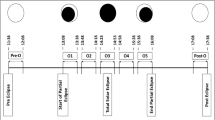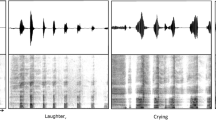Abstract
The fee–bee song of the black-capped chickadee (Poecile atricapillus) is a two-note, tonal song that can be sung at different absolute pitches within an individual. However, these two notes are produced at a consistent relative pitch. Moreover, dominant birds more reliably produce songs with this species-typical interval, compared to subordinate birds. Therefore, we asked whether presenting the species-typical relative pitch interval would aid chickadees in solving pitch interval discriminations. We found that species-typical relative pitch intervals selectively facilitated discrimination performance using synthetic sine-wave stimuli. Using shifted fee–bee song notes from recordings of naturally produced songs, birds learned the discrimination in fewer trials overall compared to synthetic stimuli. These results may reflect greater generalization among stimuli that occur outside species-typical production parameters. In addition, although sex differences in performance are rarely observed in acoustic discriminations in chickadees, female chickadees performed more accurately compared to males.






Similar content being viewed by others
References
Avey MT, Quince AF, Sturdy CB (2008) Seasonal and diurnal patterns of black-capped chickadee (Poecile atricapillus) vocal production. Behav Process 77:149–155
Bachorowski J-A, Owren MJ (1999) Acoustic correlates of talker sex and individual talker identity are present in a short vowel segment produced in running speech. J Acoust Soc Am 106:1054–1063
Baerends GP, Drent RH, Hogan-Warburg AJ, Blokzijl GJ, van der Molen AG, de Vos OC, Baarda HJ, Mudde MJ, Kruijt JP, Vodegel R (1982) The herring gull and its egg: part II. The responsiveness to egg-features. Behaviour 82:I-XIII+1-416
Baharloo S, Johnston PA, Service SK, Gitschier J, Freimer NB (1998) Absolute pitch: an approach for identification of genetic and nongenetic components. Am J Hum Genet 64:224–231
Bloomfield LL, Farrell TM, Sturdy CB (2008) All “chick-a-dee” calls are not created equally. Part II. Mechanisms for discrimination by sympatric and allopatric chickadees. Behav Process 77:87–99
Charrier I, Lee TT-Y, Bloomfield LL, Sturdy CB (2005) Acoustic mechanisms of note-type perception in black-capped chickadee (Poecile atricapillus) calls. J Comp Psychol 119:371–380
Christie PJ, Mennill DJ, Ratcliffe LM (2003) Chickadee song structure is individually distinctive over long broadcast distances. Behaviour 141:101–124
Christie PJ, Mennill DJ, Ratcliffe LM (2004) Pitch shifts and song structure indicate male quality in the dawn chorus of black-capped chickadees. Behav Ecol Sociobiol 55:341–348
Cusato B, Domjan M (1998) Special efficacy of sexual conditioned stimuli that include species typical cues: tests with a conditioned stimuli preexposure design. Learn Motiv 29:152–167
Cynx J, Hulse SH, Polyzois S (1986) A psychophysical measure of pitch discrimination loss resulting from a frequency range constraint in European starlings (Sturnus vulgaris). J Exp Psychol 12:394–402
de Kort SR, Eldermire ERB, Valderrama S, Botero CA, Vehrencamp SL (2009) Trill consistency is an age-related assessment signal in banded wrens. Proc R Soc Biol Sci 276:2315–2321
Ficken MS, Ficken RW, Witkin SR (1978) Vocal repertoire of the black-capped chickadee. Auk 95:34–48
Foree DD, LoLordo VM (1973) Attention in the pigeon: differential effects of food-getting versus shock-avoidance procedures. J Comp Phys Psychol 85:551–558
Friedrich A, Zentall T, Weisman RG (2007) Absolute pitch: Frequency-range discriminations in pigeons (Columba livia)—comparisons with zebra finches (Taeniopygia guttata) and humans (Homo sapiens). J Comp Psychol 121:95–105
Garcia J, Koelling RA (1966) Relation of cue to consequence in avoidance learning. Psychonomic Sci 4:123–124
Guillette LM, Reddon AR, Hurd PL, Sturdy CB (2009) Exploration of a novel space is associated with individual differences in learning speed in black-capped chickadees, Poecile atricapillus. Behav Process 82:265–270
Guillette LM, Farrell TM, Hoeschele M, Nickerson CM, Dawson MRW, Sturdy CB (2010) Mechanisms of call note-type perception in black-capped chickadees (Poecile atricapillus): peak shift in a note-type continuum. J Comp Psychol 124:109–115
Hoeschele M, Moscicki MK, Otter KA, van Oort H, Fort KT, Farrell TM, Lee H, Robson SWJ, Sturdy CB (2010) Dominance signalled in an acoustic ornament. Anim Behav 79:657–664
Hoeschele M, Cook RG, Guillette LM, Brooks DI, Sturdy CB (2012) Black-capped chickadee (Poecile atricapillus) and human (Homo sapiens) chord discrimination. J Comp Psychol 126:57–67
Horn AG, Leonard ML, Ratcliffe L, Shackleton SA, Weisman RG (1992) Frequency variation in songs of black-capped chickadees (Parus atricapillus). Auk 109:847–852
Hulse SH, Cynx J (1985) Relative pitch perception is constrained by absolute pitch in songbirds (Mimus, Molothrus, and Sturnus). J Comp Psychol 99:176–196
Hulse SH, Cynx J, Humpal J (1984) Absolute and relative pitch discrimination in serial pitch perception by birds. J Exp Psychol 113:38–54
Kelley MJ (1986) Selective attention and stimulus-reinforcer interactions in the pigeon. Q J Exp Psychol 38B:97–110
Kling JW, Riggs LA (eds) (1971) Woodworth and Schlosberg’s experimental psychology. Holt, Rinehart & Winston, New York
Lohr B (2008) Pitch-related cues in the songs of sympatric mountain and black-capped chickadees. Behav Process 77:156–165
Mennill DJ, Ratcliffe LM, Boag PT (2002) Female eavesdropping on male song contests in songbirds. Am Assoc Adv Sci 296:873
Moore BCJ (1989) An introduction to the psychology of hearing, 3rd edn. Academic Press, London
Njegovan M, Weisman RG (1997) Pitch discrimination in field- and isolation-reared black-capped chickadees (Parus atricapillus). J Comp Psychol 111:294–301
Njegovan M, Hilhorst B, Ferguson S, Weisman R (1994) A motor driven feeder for operant training in songbirds. Behav Res Methods Instrum Comput 26:26–27
Otter K, Ratcliffe L (1993) Changes in singing behavior of male black-capped chickadees (Parus atricapilus) following mate removal. Behav Ecol Sociobiol 33(6):409–414
Palya WL, Walter DE (2001) Document set for the high-performance experiment controller. http://www.jsu.edu/depart/psychology/sebac/Exp-Ctl.html. Accessed June 25, 2011
Proppe DS, Avey MT, Hoeschele M, Moscicki MK, Farrell T, Cassady St. Clair C, Sturdy CB (in press) Black-capped chickadees sing at higher pitches with elevated anthropogenic noise, but not with decreasing canopy cover. J Avian Biol
Pyle P (1997) Identification guide to North American birds. Slate Creek Press, Bolinas
Schindler CW, Weiss SJ (1982) The influence of positive and negative reinforcement on selective attention in the rat. Learn Motiv 13:304–323
Smith SM (1991) The black-capped chickadee: Behavioral ecology and natural history. Cornell University Press, Ithaca
Sturdy CB, Weisman RG (2006) Rationale and methodology for testing auditory cognition in songbirds. Behav Process 72:265–272
Weisman RG, Ratcliffe LM, Johnsrude I, Hurly TA (1990) Absolute and relative pitch production in the song of the black-capped chickadee. Condor 92:118–124
Weisman RG, Njegovan M, Ito S (1994) Frequency ratio discrimination by zebra finches (Taeniopygia guttata) and humans (Homo sapiens). J Comp Psychol 108:363–372
Weisman RG, Njegovan M, Sturdy CB, Phillmore LS, Coyle J, Mewhort DJK (1998) Frequency range discriminations: special and general abilities in zebra finches (Taeniopygia guttata) and humans (Homo sapiens). J Comp Psychol 112:244–258
Weisman RG, Njegovan MG, Williams MT, Cohen JS, Sturdy CB (2004) A behavior analysis of absolute pitch: sex, experience, and species. Behav Process 66:289–307
Weisman RG, Njegovan MG, Williams M, Cohen J, Sturdy CB (2006) The comparative psychology of absolute pitch. In: Wasserman EA, Zentall T (eds) Comparative cognition: experimental explorations of animal intelligence. Oxford University Press, Oxford, pp 71–86
Acknowledgments
This study was conducted in accordance with the Canadian Council on Animal Care Guidelines and Policies with approval from the Animal Care and Use Committee for Biosciences for the University of Alberta and the University of Calgary Life and Environmental Sciences Animal Care Committee. Chickadees were captured and research was carried out under an Environment Canada Canadian Wildlife Service Scientific permit, Alberta Fish and Wildlife Capture and Research permits, and City of Edmonton Parks Permit. This research was supported by a Natural Sciences and Engineering Research Council of Canada (NSERC) Discovery Grant, an NSERC Discovery Accelerator Supplement, an Alberta Ingenuity Fund (AIF) New Faculty Grant, a Canada Foundation for Innovation (CFI) New Opportunities Grant, and the CFI Infrastructure Operating Fund along with start-up funding and CFI partner funding from the University of Alberta to CBS. MH was supported by Queen Elizabeth II Graduate Scholarship, an NSERC Post-Graduate Scholarship-Doctoral award, and an Alberta Ingenuity Graduate Student Scholarship. LMG was supported by an Izaak Walton Killam Memorial Scholarship. We would like to thank Tara Farrell, Dawson Clary, Shannon Wowk, Ashley Mckillop, Craig Anderson, Justin Duval, and Jon Gaspar for their help running this experiment. We would also like to thank Lou Omerzu and Isaac Lank for their many hours of expert and excellent technical support.
Author information
Authors and Affiliations
Corresponding author
Rights and permissions
About this article
Cite this article
Hoeschele, M., Guillette, L.M. & Sturdy, C.B. Biological relevance of acoustic signal affects discrimination performance in a songbird. Anim Cogn 15, 677–688 (2012). https://doi.org/10.1007/s10071-012-0496-8
Received:
Revised:
Accepted:
Published:
Issue Date:
DOI: https://doi.org/10.1007/s10071-012-0496-8




